Demonstrating the Potential of a Low-Cost Soil Moisture Sensor Network
Abstract
1. Introduction
2. Materials and Methods
2.1. Instrumentation
2.2. Reagents and Methods
2.2.1. Intersensor Variability in Dielectric Standards
2.2.2. Soil Testing
2.2.3. Data Communication Testing
3. Results and Discussion
3.1. Sensor Performance Evaluation with Known Dielectric Standards and Intersensor Variability
3.2. Cross-Comparison with TDR Sensor for Varying θ
3.3. Sources of Errors
3.4. LoRaWAN Performance
4. Conclusions
Author Contributions
Funding
Institutional Review Board Statement
Informed Consent Statement
Data Availability Statement
Acknowledgments
Conflicts of Interest
References
- Susha Lekshmi, S.U.; Singh, D.N.; Shojaei Baghini, M. A critical review of soil moisture measurement. Meas. J. Int. Meas. Confed. 2014, 54, 92–105. [Google Scholar] [CrossRef]
- Seneviratne, S.I.; Corti, T.; Davin, E.L.; Hirschi, M.; Jaeger, E.B.; Lehner, I.; Orlowsky, B.; Teuling, A.J. Investigating soil moisture-climate interactions in a changing climate: A review. Earth-Sci. Rev. 2010, 99, 125–161. [Google Scholar] [CrossRef]
- Green, J.K.; Seneviratne, S.I.; Berg, A.M.; Findell, K.L.; Hagemann, S.; Lawrence, D.M.; Gentine, P. Large influence of soil moisture on long-term terrestrial carbon uptake. Nature 2019, 565, 476–479. [Google Scholar] [CrossRef] [PubMed]
- Zhao, M.; Running, S.W. Drought-induced reduction in global terrestrial net primary production from 2000 through 2009. Science 2010, 329, 940–943. [Google Scholar] [CrossRef]
- Humphrey, V.; Zscheischler, J.; Ciais, P.; Gudmundsson, L.; Sitch, S.; Seneviratne, S.I. Sensitivity of atmospheric CO2 growth rate to observed changes in terrestrial water storage. Nature 2018, 560, 628–631. [Google Scholar] [CrossRef] [PubMed]
- Larson, K.M.; Small, E.E.; Gutmann, E.D.; Bilich, A.L.; Braun, J.J.; Zavorotny, V.U. Use of GPS receivers as a soil moisture network for water cycle studies. Geophys. Res. Lett. 2008, 35, L24405. [Google Scholar] [CrossRef]
- Zreda, M.; Desilets, D.; Ferré, T.P.A.; Scott, R.L. Measuring soil moisture content non-invasively at intermediate spatial scale using cosmic-ray neutrons. Geophys. Res. Lett. 2008, 35, L21402. [Google Scholar] [CrossRef]
- Franz, T.E.; Zreda, M.; Rosolem, R.; Ferre, T.P.A. A universal calibration function for determination of soil moisture with cosmic-ray neutrons. Hydrol. Earth Syst. Sci. 2013, 17, 453–460. [Google Scholar] [CrossRef]
- Peng, J.; Loew, A.; Merlin, O.; Verhoest, N.E.C. A review of spatial downscaling of satellite remotely sensed soil moisture. Rev. Geophys. 2017, 55, 341–366. [Google Scholar] [CrossRef]
- Paloscia, S.; Pettinato, S.; Santi, E.; Notarnicola, C.; Pasolli, L.; Reppucci, A. Soil moisture mapping using Sentinel-1 images: Algorithm and preliminary validation. Remote Sens. Environ. 2013, 134, 234–248. [Google Scholar] [CrossRef]
- Mittelbach, H.; Casini, F.; Lehner, I.; Teuling, A.J.; Seneviratne, S.I. Soil moisture monitoring for climate research: Evaluation of a low-cost sensor in the framework of the Swiss soil moisture experiment (SwissSMEX) campaign. J. Geophys. Res. Atmos. 2011, 116. [Google Scholar] [CrossRef]
- Vaz, C.M.P.; Jones, S.; Meding, M.; Tuller, M. Evaluation of Standard Calibration Functions for Eight Electromagnetic Soil Moisture Sensors. Vadose Zone J. 2013, 12, vzj2012.0160. [Google Scholar] [CrossRef]
- Bogena, H.R.; Huisman, J.A.; Schilling, B.; Weuthen, A.; Vereecken, H. Effective calibration of low-cost soil water content sensors. Sensors 2017, 17, 208. [Google Scholar] [CrossRef] [PubMed]
- Blonquist, J.M.; Jones, S.B.; Robinson, D.A. Standardizing Characterization of Electromagnetic Water Content Sensors: Part 2. Evaluation of Seven Sensing Systems. Vadose Zone J. 2005, 4, 1059–1069. [Google Scholar] [CrossRef]
- Majone, B.; Viani, F.; Filippi, E.; Bellin, A.; Massa, A.; Toller, G.; Robol, F.; Salucci, M. Wireless Sensor Network Deployment for Monitoring Soil Moisture Dynamics at the Field Scale. Procedia Environ. Sci. 2013, 19, 426–435. [Google Scholar] [CrossRef]
- Datta, S.; Taghvaeian, S.; Ochsner, T.E.; Moriasi, D.; Gowda, P.; Steiner, J.L. Performance assessment of five different soil moisture sensors under irrigated field conditions in Oklahoma. Sensors 2018, 18, 3786. [Google Scholar] [CrossRef]
- Navarro-Hellín, H.; Torres-Sánchez, R.; Soto-Valles, F.; Albaladejo-Pérez, C.; López-Riquelme, J.A.; Domingo-Miguel, R. A wireless sensors architecture for efficient irrigation water management. Agric. Water Manag. 2015, 151, 64–74. [Google Scholar] [CrossRef]
- Martini, E.; Werban, U.; Zacharias, S.; Pohle, M.; Dietrich, P.; Wollschläger, U. Repeated electromagnetic induction measurements for mapping soil moisture at the field scale: Validation with data from a wireless soil moisture monitoring network. Hydrol. Earth Syst. Sci. 2017, 21, 495–513. [Google Scholar] [CrossRef]
- Valente, A.; Silva, S.; Duarte, D.; Pinto, F.C.; Soares, S. Low-cost lorawan node for agro-intelligence iot. Electronics 2020, 9, 987. [Google Scholar] [CrossRef]
- Hamed, Y.; Samy, G.; Persson, M. Evaluation of the WET sensor compared to time domain reflectometry. Hydrol. Sci. J. 2006, 51, 671–681. [Google Scholar] [CrossRef]
- Topp, G.C.; Davis, J.L.; Annan, A.P. Electromagnetic determination of soil water content: Measurements in coaxial transmission lines. Water Resour. Res. 1980, 16, 574–582. [Google Scholar] [CrossRef]
- Jones, S.B.; Blonquist, J.M.; Robinson, D.A.; Rasmussen, V.P.; Or, D. Standardizing Characterization of Electromagnetic Water Content Sensors: Part 1. Methodology. Vadose Zone J. 2005, 4, 1048–1058. [Google Scholar] [CrossRef]
- Kargas, G.; Soulis, K.X. Performance Analysis and Calibration of a New Low-Cost Capacitance Soil Moisture Sensor. J. Irrig. Drain. Eng. 2012, 138, 632–641. [Google Scholar] [CrossRef]
- Mohsen-Nia, M.; Amiri, H. Measurement and modelling of static dielectric constants of aqueous solutions of methanol, ethanol and acetic acid at T = 293.15 K and 91.3 kPa. J. Chem. Thermodyn. 2013, 57, 67–70. [Google Scholar] [CrossRef]
- Wyman, J. The dielectric constant of mixtures of ethyl alcohol and water from −5 to 40°. J. Am. Chem. Soc. 1931, 53, 3292–3301. [Google Scholar] [CrossRef]
- Seyfried, M.S.; Grant, L.E.; Du, E.; Humes, K. Dielectric Loss and Calibration of the Hydra Probe Soil Water Sensor. Vadose Zone J. 2005, 4, 1070–1079. [Google Scholar] [CrossRef]
- Young, M.H.; Fleming, J.B.; Wierenga, P.J.; Warrick, A.W. Rapid Laboratory Calibration of Time Domain Reflectometry Using Upward Infiltration. Soil Sci. Soc. Am. J. 1997, 61, 707–712. [Google Scholar] [CrossRef]
- Schaap, M.G.; De Lange, L.; Heimovaara, T.J. TDR calibration of organic forest floor media. Soil Technol. 1997, 11, 205–217. [Google Scholar] [CrossRef]
- Roth, C.H.; Malicki, M.A.; Plagge, R. Empirical evaluation of the relationship between soil dielectric constant and volumetric water content as the basis for calibrating soil moisture measurements by TDR. J. Soil Sci. 1992, 43, 1–13. [Google Scholar] [CrossRef]
- Blonquist, J.M.; Jones, S.B.; Lebron, I.; Robinson, D.A. Microstructural and phase configurational effects determining water content: Dielectric relationships of aggregated porous media. Water Resour. Res. 2006, 42, W05424. [Google Scholar] [CrossRef]
- Sakaki, T.; Rajaram, H. Performance of different types of time domain reflectometry probes for water content measurement in partially saturated rocks. Water Resour. Res. 2006, 42, W07404. [Google Scholar] [CrossRef]
- Regalado, C.M.; Ritter, A.; Rodríguez-González, R.M. Performance of the Commercial WET Capacitance Sensor as Compared with Time Domain Reflectometry in Volcanic Soils. Vadose Zone J. 2007, 6, 244254. [Google Scholar] [CrossRef]
- Bouksila, F.; Persson, M.; Berndtsson, R.; Bahri, A. Soil water content and salinity determination using different dielectric methods in saline gypsiferous soil. Hydrol. Sci. J. 2008, 53, 253–265. [Google Scholar] [CrossRef]
- Di Vincenzo, V.; Heusse, M.; Tourancheau, B. Improving Downlink Scalability in LoRaWAN. In Proceedings of the IEEE International Conference on Communications, Shanghai, China, 20–24 May 2019; pp. 1–7. [Google Scholar] [CrossRef][Green Version]
- Kufakunesu, R.; Hancke, G.P.; Abu-Mahfouz, A.M. A survey on adaptive data rate optimization in lorawan: Recent solutions and major challenges. Sensors 2020, 20, 5044. [Google Scholar] [CrossRef] [PubMed]
- Adelantado, F.; Vilajosana, X.; Tuset-Peiro, P.; Martinez, B.; Melia-Segui, J.; Watteyne, T. Understanding the Limits of LoRaWAN. IEEE Commun. Mag. 2017, 55, 34–40. [Google Scholar] [CrossRef]
- Okafor, N.U.; Delaney, D.T. Missing Data Imputation on IoT Sensor Networks: Implications for on-site Sensor Calibration. IEEE Sens. J. 2021, 21, 22833–22845. [Google Scholar] [CrossRef]
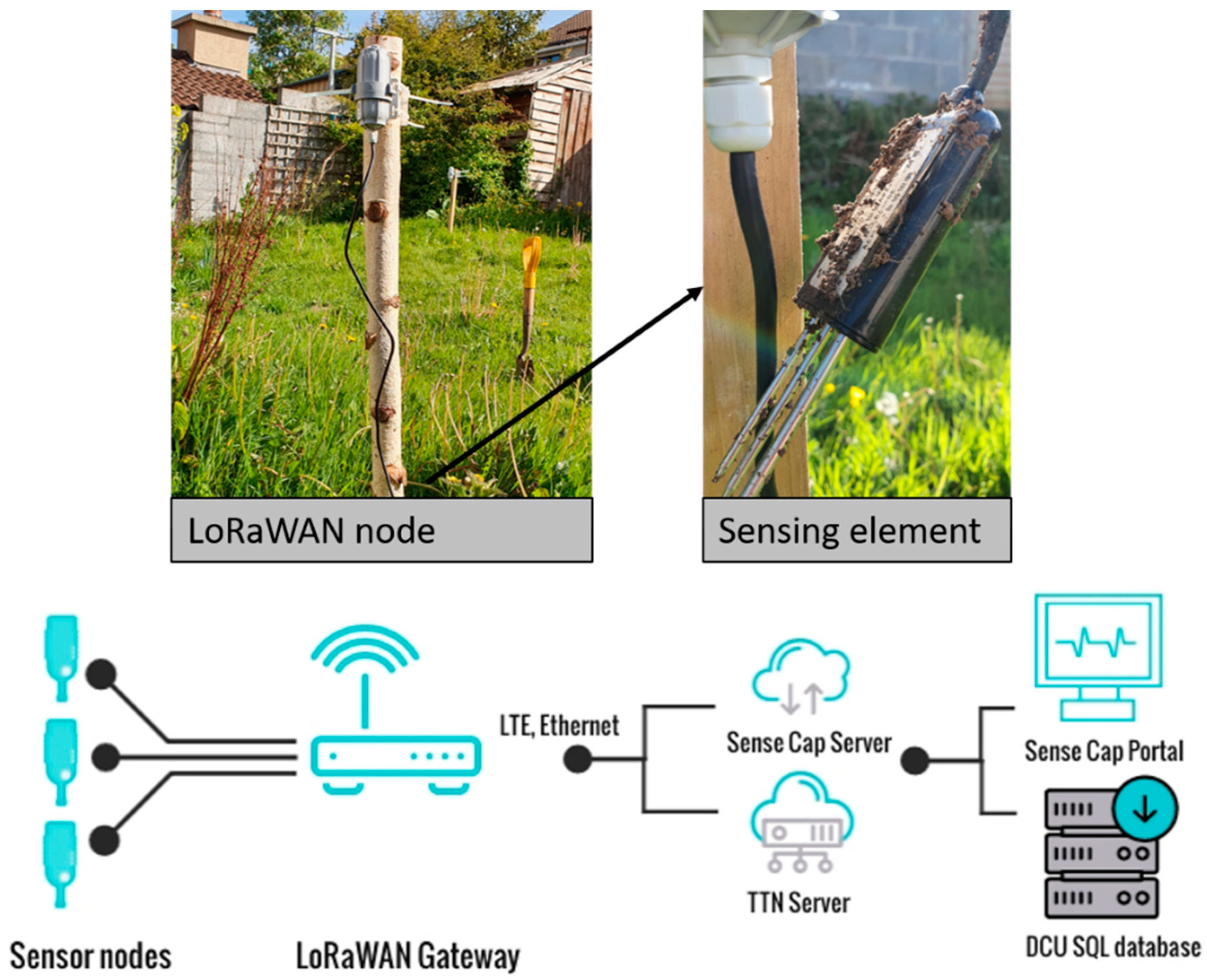
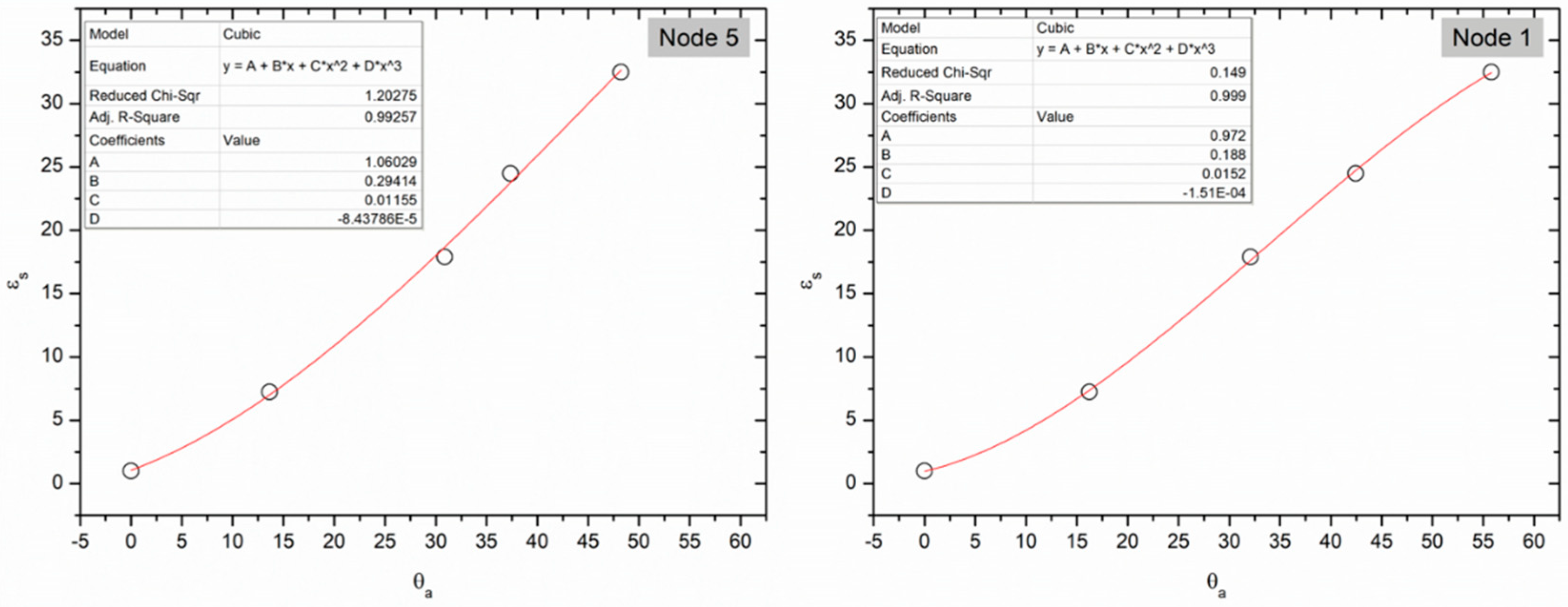
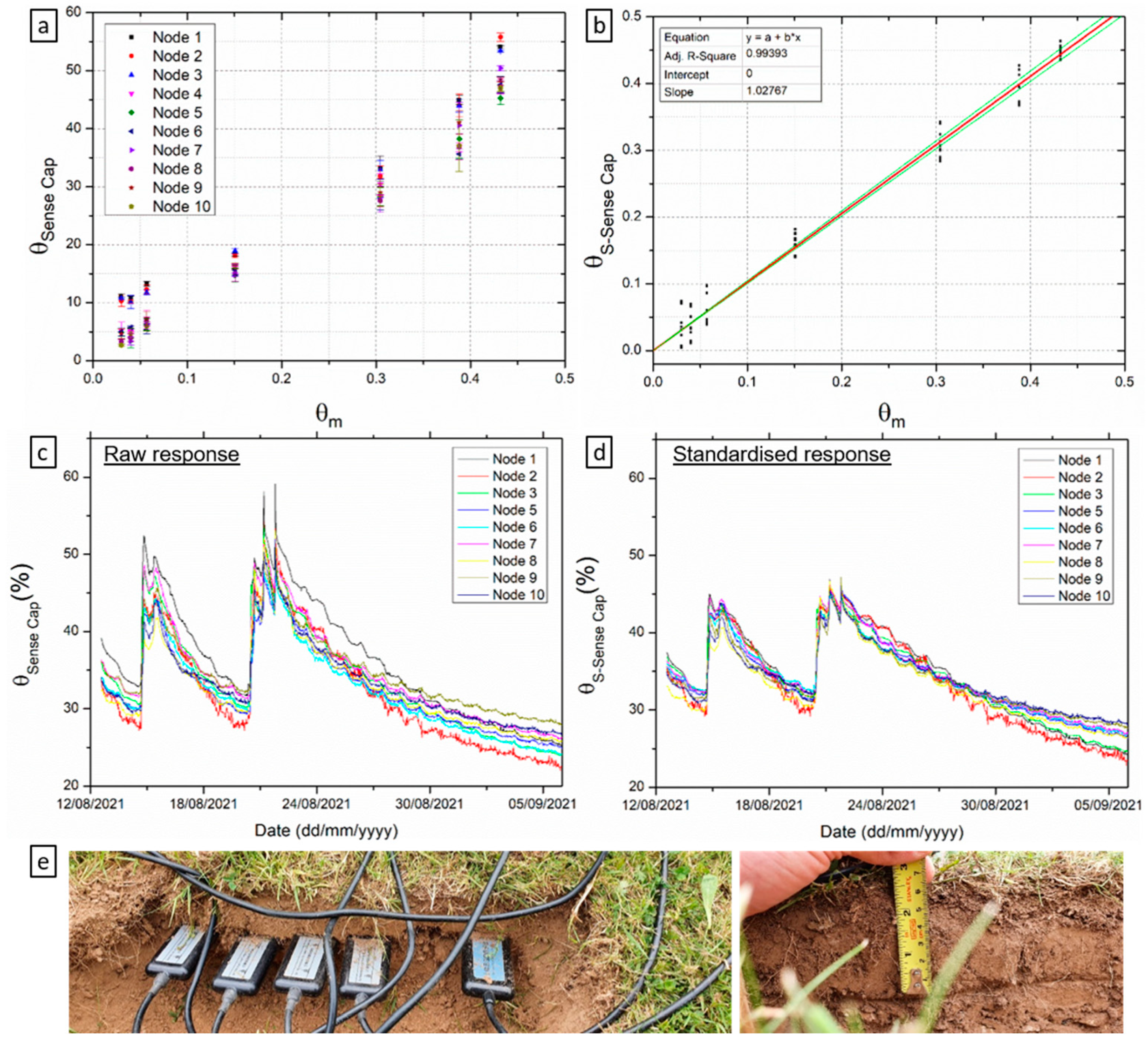
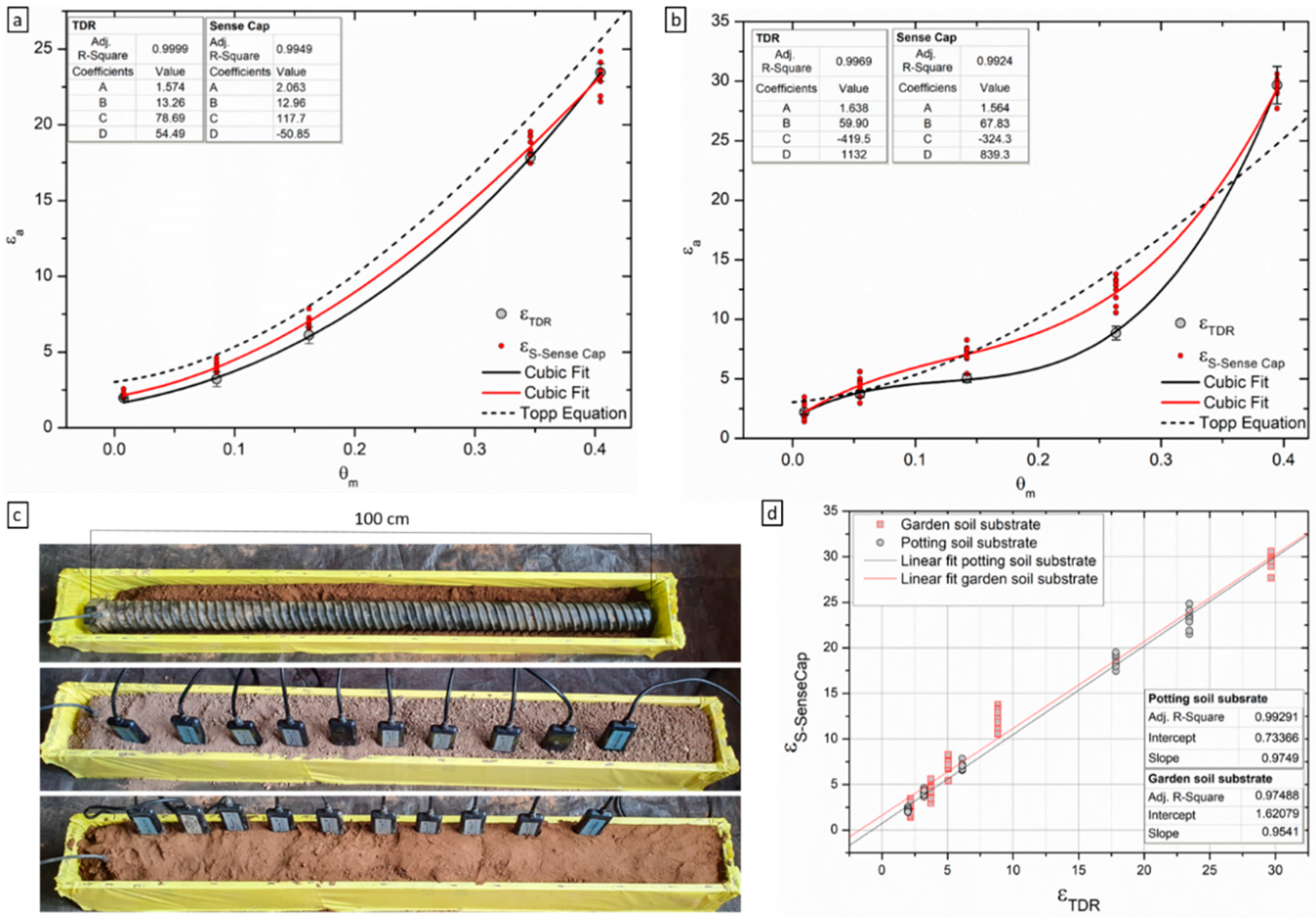
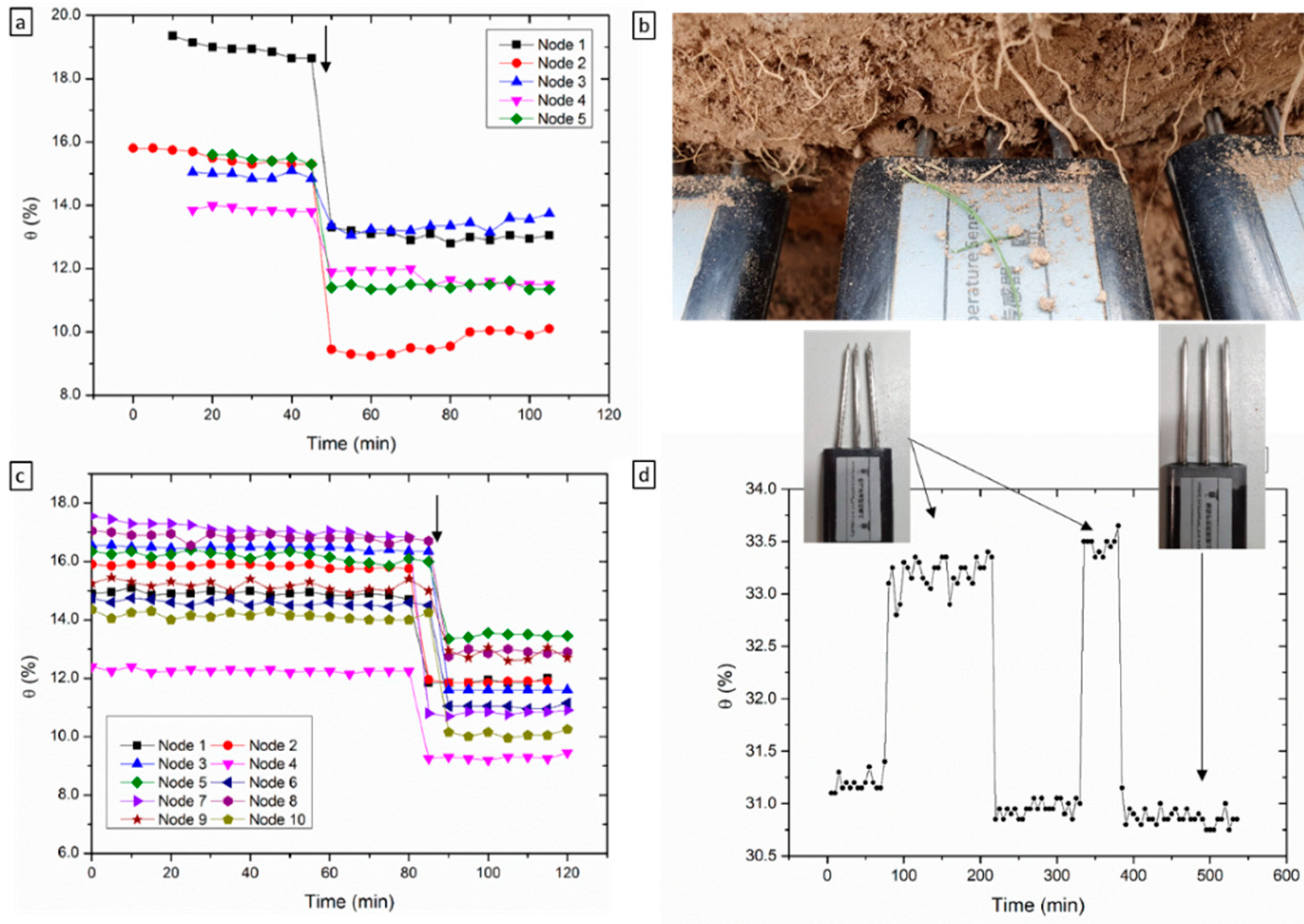

| Distance from Gateway (m) | 40 | 100 | 300 | 460 |
|---|---|---|---|---|
| Node ID | 1, 2 | 3, 4 | 5, 6 | 7, 8 |
| Media | εs (F m−1) | εa (F m−1) | |||||||||
|---|---|---|---|---|---|---|---|---|---|---|---|
| Node 1 | Node 2 | Node 3 | Node 4 | Node 5 | Node 6 | Node 7 | Node 8 | Node 9 | Node 10 | ||
| Air | 1 | 1.88 | 1.88 | 1.88 | 1.88 | 1.88 | 1.88 | 1.88 | 1.88 | 1.88 | 1.88 |
| AA | 7.25 * | 8.71 | 8.11 | 8.23 | 7.07 | 7.48 | 6.56 | 7.37 | 7.58 | 7.44 | 7.32 |
| IPA | 17.9 | 18.10 ± 0.06 | 16.19 ± 0.21 | 16.85 ± 0.144 | 18.10 ± 0.22 | 17.22 ± 0.11 | 16.84 ± 1.01 | 18.26 ± 0.55 | 18.11 ± 0.52 | 18.51 ± 0.08 | 17.18 ± 0.67 |
| Ethanol | 24.5 | 27.62 ± 0.05 | 23.80 ± 0.18 | 24.69 ± 0.49 | 24.70 ± 0.90 | 22.41 ± 0.05 | 22.95 ± 1.45 | 24.45 ± 0.43 | 24.20 ± 0.93 | 25.88 ± 0.46 | 24.81 ± 2.08 |
| Methanol | 32.5 | 48.17 ± 0.22 | 46.68 ± 0.39 | 48.59 ± 0.44 | 43.41 ± 0.10 | 35.42 ± 1.38 | 39.11 ± 0.19 | 41.94 ± 0.30 | 40.66 ± 0.25 | 38.61 ± 1.15 | 42.44 ± 1.11 |
| Mix 1 ** | 42.99 ** | 67.07 ± 1.44 | 62.77 ± 1.61 | 65.04 ± 1.63 | 53.01 ± 1.14 | 47.66 ± 1.02 | 49.96 ± 0.99 | 51.35 ± 1.37 | 51.16 ± 1.16 | 52.91 ± 0.13 | 50.54 ± 0.25 |
| Mix 2 ** | 60.9 ** | 78.61 ± 1.11 | 76.98 ± 1.84 | 76.88 ± 1.88 | 77.87 ± 0.23 | 75.50 ± 1.31 | 80.25 ± 2.40 | 77.61 ± 1.34 | 79.02 ± 0.79 | 78.60 ± 1.55 | 75.58 ± 2.58 |
| H2O | 80.1 | 81.36 ± 0.05 | 81.30 ± 0.29 | 81.39 ± 0.06 | 81.14 ± 0.01 | 81.14 ± 0.25 | 81.17 ± 0.03 | 81.15 ± 0.02 | 81.12 ± 0.04 | 81.17 ± 0.07 | 81.12 ± 0.02 |
| Range | 40 m | 100 m | 300 m | 460 m |
|---|---|---|---|---|
| Antenna A | 5.48% | 1.15% | 3.83% | 13.64% |
| Antenna B | 6.81% | 1.91% | 4.91% | 9.69% |
| Nantenna A | 1569 | 1560 | 1565 | 1547 |
| Nantenna B | 2510 | 2511 | 2506 | 2509 |
Publisher’s Note: MDPI stays neutral with regard to jurisdictional claims in published maps and institutional affiliations. |
© 2022 by the authors. Licensee MDPI, Basel, Switzerland. This article is an open access article distributed under the terms and conditions of the Creative Commons Attribution (CC BY) license (https://creativecommons.org/licenses/by/4.0/).
Share and Cite
Briciu-Burghina, C.; Zhou, J.; Ali, M.I.; Regan, F. Demonstrating the Potential of a Low-Cost Soil Moisture Sensor Network. Sensors 2022, 22, 987. https://doi.org/10.3390/s22030987
Briciu-Burghina C, Zhou J, Ali MI, Regan F. Demonstrating the Potential of a Low-Cost Soil Moisture Sensor Network. Sensors. 2022; 22(3):987. https://doi.org/10.3390/s22030987
Chicago/Turabian StyleBriciu-Burghina, Ciprian, Jiang Zhou, Muhammad Intizar Ali, and Fiona Regan. 2022. "Demonstrating the Potential of a Low-Cost Soil Moisture Sensor Network" Sensors 22, no. 3: 987. https://doi.org/10.3390/s22030987
APA StyleBriciu-Burghina, C., Zhou, J., Ali, M. I., & Regan, F. (2022). Demonstrating the Potential of a Low-Cost Soil Moisture Sensor Network. Sensors, 22(3), 987. https://doi.org/10.3390/s22030987







